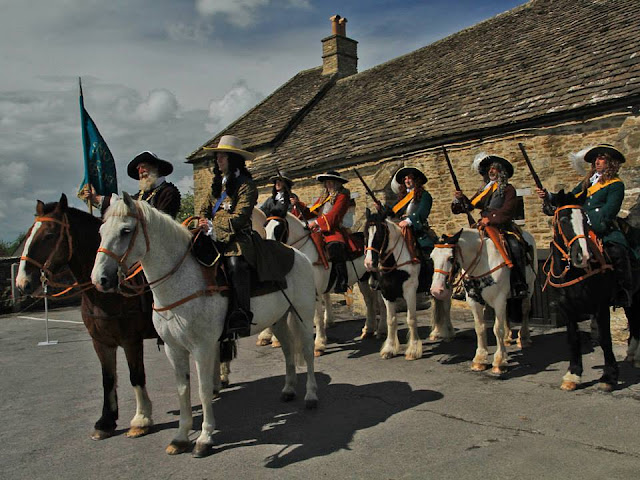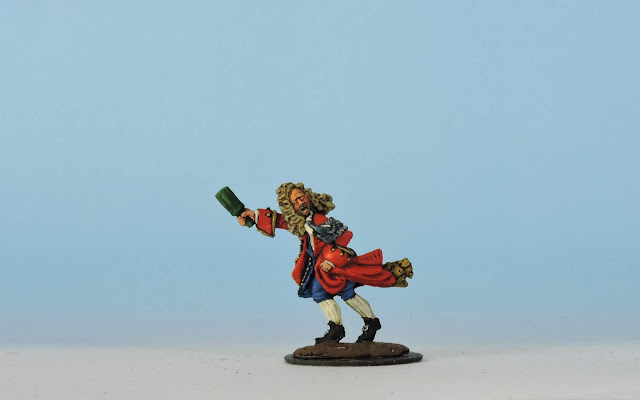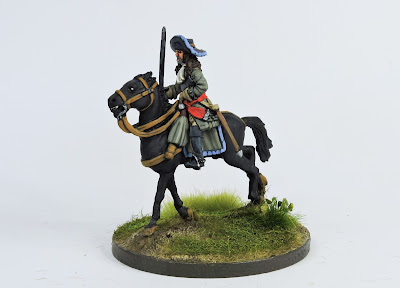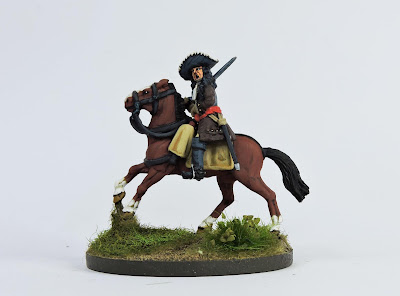 |
| A few militia style clothes may have been the most uniformed anyone got in Monmouth's Army |
To describe the rebel forces as an army is probably being somewhat overgenerous. Several of the officer cadre including the Duke himself were soldiers, brave, proven and with battle experience gained in formal, continental wars. There were undoubtedly ex soldiers, deserters from the army, militiamen and mercenaries forming a portion of the regiments however, the majority of the men were volunteers, whipped up to rebel against something - the King, Popery, oppression and the usual causes trotted out to get the masses mobilized by their political lords and masters.
 |
| Not everyone came out for King Monmouth. This however may be a scene from the Bloody Assizes |
Monmouth landed on June 11 and was executed on July 15. Even the most zealous supporter of the cause would have difficulty in arguing that the assembled volunteers could have been moulded into an army with the necessary organization, command structure, campaign plan, logistical support, weaponry, uniforms and battle tactics in less than one month.
 |
| A very old shot of my attempt to model Monmouth troops in the late 1990s |
This was a civil insurrection led by military men. The regiments, named for colours or after their colonels would have been much like large, moving football crowds. Cadenced marching, drill, company organization and other necessary and rudimentary elements would have been embryonic at best but most likely - completely absent.
 |
| An interesting representation of Monmouth's Mounted Lifeguard by permission of the Kelmarsh Group/Alan Larsen |
On the whole, the formations were larger than the Royal battalions but without the institutional money and resources available to the army, one must conclude the whole would have somewhat of the appearance of a large and motivated mob.
 |
| King Monmouth and his standard bearer - by permission of the Kelmarsh Group/Alan Larsen. |
The variety of clothing and weapons on show would have been a cross section of what was available from personal possessions, local arsenals, Civil War hand-me downs, the stock from the caches of local great men and what Monmouth was able to bring with him from Holland, reportedly - four light guns and 1,500 muskets.
 |
| Monmouth's cavalry |
 |
| Farm workers and Squires |
The majority of the men would have worn their everyday clothes. Many were farm workers, labourers, artisans and merchants. Those who had deserted from local militias may have dusted a sprinkle of muted colour over an otherwise drab looking mass.
 |
| A well dressed Rebel - perhaps a European mercenary |
 |
| A deadly Scytheman - taking time off from hedge cutting |
 |
| A West Countryman? It was the Pitchfork Rebellion you know! |
The regiments have become known by colour titles -Red, White, Blue, Green and Yellow although it is more likely that at the time they would have rallied under the names of their commanding officers: Wade, Ffoulkes, Bovet, Holmes and Matthews which was the accepted tradition of the army.
 |
| The as yet unreleased Warfare Miniatures Drunken Colonel - I must get round to it |
The army may at one point have numbered nearly 6,000 but at the time of the battle this will have dwindled through small local reverses and desertions.
 |
| A Rural Mob - actually based for Donnybrook (which is great for skirmishing the Rebellion) |
Much has been made of the dreaded 'scythe-men' but these killers have to be placed in context. Why would men be using agricultural implements in battle? The only reason is the absence of military weapons. Pikes take many weeks to master individually and even more, collectively. If muskets were in short supply and pikes were not practical, a familiar tool that was used everyday by some of the volunteers is an obvious choice. The army was probably akin to a 'come as you are' party.
 |
| Our new codes V01,V02,V03 - perfect for the Rebel Army |
The scythemen would undoubtedly have made a mess of an opponent if able to get near enough and if that opponent was not fighting back with clubbed muskets, pike, bayonet or sword. A charging mob of angry scythe-men, however appealing a thought, would need to get themselves into a position of opportunity with appropriate timing and leadership to achieve anything greater than a small and very localized victory. Too much store is put by this oddity in wargaming. It has also become known as the Pitchfork Rebellion and not without reason.
 |
| From Warfare's codes V04,V05,V06 - Deadly Scythemen |
If the Jacobite Army of 1689 sponsored by the Irish Parliament and King Louis XIV was constantly short of swords, belts and muskets - the plight of a small number of admittedly wealthier English peasantry without state apparatus and an enormously wealthy tyrant behind it was likely to be not better and probably a lot worse. Particularly when the timescale of birth to death of a single month is considered.
 |
| The officers with Monmouth may have looked somewhat like this - Ffoulkes? |
The cavalry, numbering around 600 appears to have been organized in around nine troops giving an average of about 66 men per troop. Not dissimilar to the size of a regular army formation . These troops were most likely gentleman farmers and their retinues of workers, un-armoured and dressed in civilian clothes with a sprinkle of privately funded breastplates, helmets and military uniforms from some of Monmouth's cadre. Three light guns may have accompanied the army.
 |
| Matthews? |
A peasant army recruited in the summer in the West Country of England was likely to have been largely in waistcoats and shirt sleeves, armed with a wide variety of pikes, muskets, improvised weapons and possibly Civil War vintage helmets.
 |
| Wade? |
The battle formations will have been swarm like and deeper than the Royal battalions. Monmouth's force offers an interesting subject for wargaming and will share many elements of the early Jacobite and Williamite assemblies of the 1688-89 period in Ireland.
Have fun!
